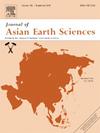燕山构造带西段与华北克拉通破坏有关的晚三叠世煌斑岩成因:年代学和地球化学约束
IF 2.7
3区 地球科学
Q2 GEOSCIENCES, MULTIDISCIPLINARY
引用次数: 0
摘要
煌斑岩是一种源自丰富的次大陆岩石圈地幔熔融作用的超古典纪火成岩,通常形成于伸展构造环境下,与同世的跨地壳作用有关。煌斑岩的成因提供了对煌斑岩岩浆的生成、储存和侵位的认识,并进一步约束了地幔源的性质。然而,煌斑岩的起源仍然是一个谜,需要进一步的研究。华北克拉通北部燕山构造带西段晚三叠世煌斑岩为了解该地区的构造演化,特别是其与克拉通破坏发生的关系提供了重要契机。本文报道了北京燕山构造带西段晚三叠世煌斑岩和石英二长斑岩的年代学和地球化学综合研究结果。LA-ICP-MS U-Pb锆石定年结果表明,煌斑岩和石英二长斑岩在235 ~ 220 Ma期间同时侵位,标志着北陆北部晚三叠世岩浆活动。晚三叠世煌斑岩和石英二长斑岩均富集大离子亲石元素(LILEs)和轻稀土元素(lree),而缺乏高场强元素(hfse),呈弧形地球化学特征。它们还表现出高MgO和总碱浓度,低二氧化硅含量。非放射性成因的全岩Nd和Hf同位素组成[εNd(t) =−11.3 ~−10.8)和(εHf(t) =−16.3 ~−12.5)]表明,三叠系岩浆可能来源于富集的岩石圈地幔源,然后是镁铁相的分步结晶和轻微的地壳同化作用。地球化学模拟表明,煌斑岩的母岩浆是由尖晶石-石榴石辉橄榄岩的低程度(< 5%)部分熔融形成的。这些结果表明,所研究的岩石可能起源于古亚洲大洋板块在北陆板块下的俯冲过程中,由流体和/或熔融交代作用富集的次大陆岩石圈地幔。晚三叠世煌斑岩的放射性成因锆石Hf同位素组成[例如εHf(t) = 6.4 ~ 8.9]表明其参与了枯竭的地幔源。在三叠纪期间,由大陆内部强烈的伸展所引发的软流圈上涌,很可能提供了融化NCC下面富集的次大陆岩石圈所需的热量。晚三叠世软流圈与岩石圈地幔之间的相互作用标志着北大陆架破坏的开始,并导致了其热机械侵蚀。本文章由计算机程序翻译,如有差异,请以英文原文为准。

Origin of Late Triassic lamprophyres in the western Yanshan Tectonic Belt related to destruction of the North China Craton: Geochronological and geochemical constraints
Lamprophyres, ultrapotassic igneous rocks generally derived from the melting of enriched subcontinental lithospheric mantle, typically form in extensional tectonic settings and are associated with coeval transcrustal processes. The genesis of lamprophyres provides insights into the generation, storage, and emplacement of lamprophyric magmas, and further constrains the nature of mantle sources. However, the origin of lamprophyres remains enigmatic and requires further investigation. The Late Triassic lamprophyres along the western Yanshan Tectonic Belt of the northern North China Craton (NCC) offer a key opportunity to understand the tectonic evolution of this region, particularly their relationship with the onset of craton destruction. Here we report the results of an integrated geochronological and geochemical study of Late Triassic lamprophyres and quartz monzonite porphyries in Beijing on the western Yanshan Tectonic Belt. U–Pb zircon dating using LA–ICP–MS reveals that the lamprophyres and quartz monzonite porphyries were emplaced contemporaneously during ca. 235–220 Ma, marking a Late Triassic magmatic event in the northern NCC. The Late Triassic lamprophyre and quartz monzonite porphyry sills are enriched in large ion lithophile elements (LILEs) and light rare earth elements (LREEs) but are depleted in high field strength elements (HFSEs), exhibiting arc-like geochemical characteristics. They also display high MgO and total alkali concentrations with low silica contents. Unradiogenic whole-rock Nd and Hf isotope compositions [(εNd(t) = −11.3 to −10.8) and (εHf(t) = −16.3 to −12.5)] indicate that the magmas of the Triassic suite were likely derived from an enriched lithospheric mantle source, followed by fractional crystallization of ferromagnesian phases and minor crustal assimilation. Geochemical modeling suggests that the parental magma of the lamprophyres was generated through a low degree (<5 %) partial melting of spinel–garnet lherzolites. These results suggest that the investigated rocks originated from a subcontinental lithospheric mantle enriched by fluid and/or melt metasomatism, likely during subduction of the Paleo-Asian oceanic plate beneath the NCC. Radiogenic zircon Hf isotope compositions [e.g., εHf(t) = 6.4 to 8.9] of the Late Triassic lamprophyres point to the involvement of a depleted mantle source. The upwelling of the asthenosphere, triggered by intensive intra-continental extension during the Triassic, likely provided the heat required to melt the enriched subcontinental lithosphere beneath the NCC. This Late Triassic interaction between the asthenosphere and the lithospheric mantle marks the onset of NCC destruction and contributed to its thermo-mechanical erosion.
求助全文
通过发布文献求助,成功后即可免费获取论文全文。
去求助
来源期刊

Journal of Asian Earth Sciences
地学-地球科学综合
CiteScore
5.90
自引率
10.00%
发文量
324
审稿时长
71 days
期刊介绍:
Journal of Asian Earth Sciences has an open access mirror journal Journal of Asian Earth Sciences: X, sharing the same aims and scope, editorial team, submission system and rigorous peer review.
The Journal of Asian Earth Sciences is an international interdisciplinary journal devoted to all aspects of research related to the solid Earth Sciences of Asia. The Journal publishes high quality, peer-reviewed scientific papers on the regional geology, tectonics, geochemistry and geophysics of Asia. It will be devoted primarily to research papers but short communications relating to new developments of broad interest, reviews and book reviews will also be included. Papers must have international appeal and should present work of more than local significance.
The scope includes deep processes of the Asian continent and its adjacent oceans; seismology and earthquakes; orogeny, magmatism, metamorphism and volcanism; growth, deformation and destruction of the Asian crust; crust-mantle interaction; evolution of life (early life, biostratigraphy, biogeography and mass-extinction); fluids, fluxes and reservoirs of mineral and energy resources; surface processes (weathering, erosion, transport and deposition of sediments) and resulting geomorphology; and the response of the Earth to global climate change as viewed within the Asian continent and surrounding oceans.
 求助内容:
求助内容: 应助结果提醒方式:
应助结果提醒方式:


